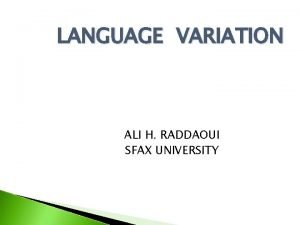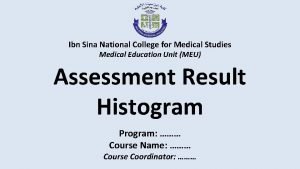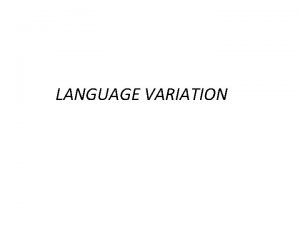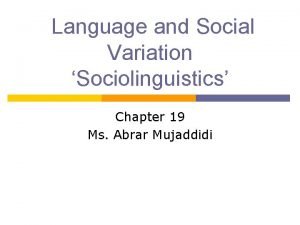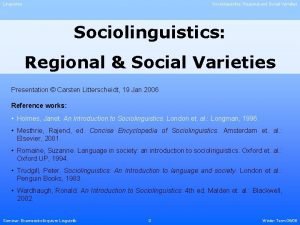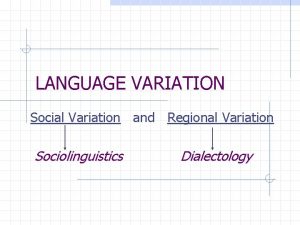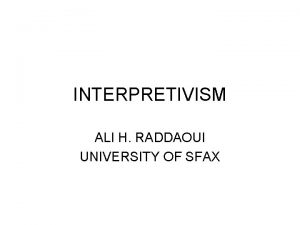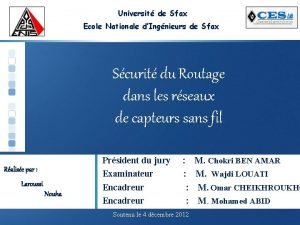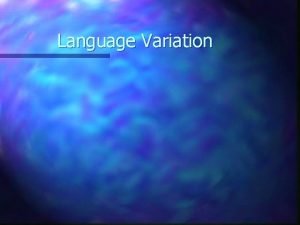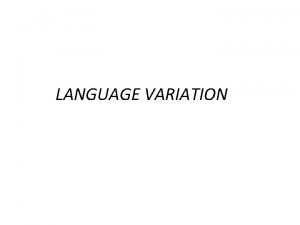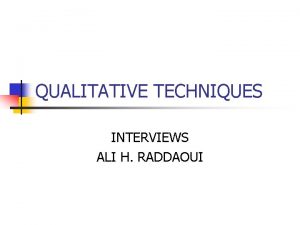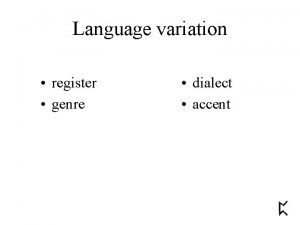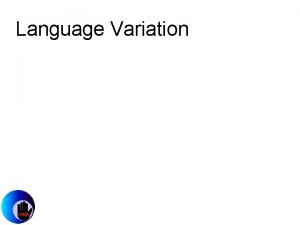LANGUAGE VARIATION ALI H RADDAOUI SFAX UNIVERSITY LECTURE













- Slides: 13

LANGUAGE VARIATION ALI H. RADDAOUI SFAX UNIVERSITY

LECTURE ROADMAP �The process of Standardization �Accent �Language and dialect �References

The Process of standardization � Acceptance: To be accepted by the relevant population as the standard language for a number of dialects. � Sociocultural/ideological value: Standard L serves as a strong UNIFYING FORCE; SYMBOL OF INDEPENDENCE; Language loyalty tends to unite several diverse groups and social classes, whose members may continue to speak their own vernaculars within the family circle. (Gumpers, 1977).

The Process of standardization � ◦ ◦ � � Associated incentives: ambitious citizens then learn correct forms and refrain from using incorrect forms in writing. Prestige jobs. SL has prestige that its speakers also gain. An educational system (public schools), and the mass media are busy at work, disseminating the grammar and spelling of the standard language. English in India has the status of an associate official language.

The Process of standardization � An array of functions served by SL: selected variety used in all functions associated ◦ ◦ ◦ with central government with writing, in parliament, law courts, in bureaucratic, educational and scientific documents, in various forms of literature. (New conventions to be added as per need: technical words, formulating examination questions, writing formal letters, etc. )

ACCENT � Accent: not concerned with lexis or syntax, but mainly with phonology/pronunciation. � A way of speaking that indicates a person's place of origin and/or social class: a workingclass accent, a London accent, a working-class London accent; a regional accent; an American regional accent. Concise � Oxford Companion to the English Language, 2004. Accent refers to varieties of pronunciation. (Hughes & Trudgill, 1996).

Received Pronunciation /Received Standard as Standard Pronunciation for Standard English � � � The standard form of British English pronunciation, based on educated speech in southern England, widely accepted as a standard elsewhere. It is not considered a bearer of any regional identification. ‘Neutral’ in the sense that it does not indicate where the speaker comes from. Often associated with intelligence (Hughes and Trudgill: 1996), with trust and authoritativeness. Previously referred to as Public School English: private schools beyond the means of most parents. 19 th century meaning: ‘accepted in the best society; considered the ‘best accent’; accent of the upper reaches of the social scale; measured by education, income, profession, or title. (Hughes & Trudgill, 1996). Only an estimated 3 % of the English population speaks RP.

VARIETIES OF LANGUAGE � Varieties may be arranged as a dialect continuum, a chain of adjacent varieties in which each pair of adjacent varieties are mutually intelligible, but pairs taken from opposite ends are not; � Example: the continuum from Amsterdam through Germany to Vienna.

Languages or dialects? � Varieties called popularly different languages can be mutually intelligible, but are treated as separate languages for political purposes ◦ e. g. 1. Scandinavian languages excluding Finnish and Lapp ◦ e. g. 2. Chinese dialects, supposedly instances of the same language are unintelligible. ◦ e. g. 3. Hindi and Urdu in North India: grammatically almost identical ◦ e. g. 4. Serbian and Croatian in ex-Yugoslavia � Mutual intelligibility is a matter of degree from 100 % intelligibility to 0 % intelligibility. How high up the scale do two varieties need to be in order to count as members of the same language?

LANGUAGE VARIATION � Speech community as linguistic and social or psychological correlate � The notion of the continuum: ◦ Speech communities as an elastic and changing set ◦ Dialects as overlapping varieties � Participation in various speech communities

VARIETIES AND DIALECTS � LANGUAGE ◦ L larger than D ◦ English as L is the sum total of all the terms in all its dialects ◦ Standard Eng: one dialect of L + prestige � DIALECT ◦ D smaller than L ◦ D contains less items than L; the dialect is but one of the regional or social manifestations of language ◦ Yorkshire English, Indian English as dialects- prestige; - writing system

BIBLIOGRAPHY � � � � Broom et al. 1981. Sociology. 7 th ed. New York: Harper and Row Publishers. Chambers, J. K. 1995. Sociolinguistic Theory. Cambridge, Massachusetts, Blackwell Publishers. Concise Oxford Companion to the English Language. 2004. OUP. Giglio, P. P. (Ed. ). 1977. Language and Social Context. London: Penguin Books. Goffman, E. 1977. The Neglected Situation. in Giglio, P. P. (Ed. ). Language and Social Context. London: Penguin Books. pp. 61 -66. Hobbs, P. The medium is the message: politeness strategies in men’s and women’s voice mail messages. Journal of Pragmatics 35 (2003) 243– 262 Hughes, A. & P. Trudgill. 1996. English Accents and Dialects. (Third Ed. ) Arnold: London, New York and Aukland. Hymes. 1973. Foundations in Sociolinguistics. Philadelphia: University of Pennsylvania Press.

BIBLIOGRAPHY � � � � � Hymes. D. 1964. Introduction: toward ethnographies of communication, American Anthropologist, 66, 6, 12 -25. House, J. 2003. English as a lingua franca: A threat to multilingualism? Journal of Sociolinguistics 7/4, 556 -578. Hudson, R. A. 1980. Sociolinguistics. Cambridge: CUP. Mey, I. (2001). The CA/CDA controversy. Journal of Pragmatics 33 (2001) 609 -615 Noppen, J. P. van. 2004. CDA: A discipline come of age. Journal of Sociolinguistics. 8/1, 2004. 107 -126. Pieter Muysken. 198. Book review. Journal of Pragmatics 30, 771 -773 Rajendra Singh. 1996. Towards a critical sociolinguistics. Amsterdam: Benjamins. 342 pp. Oxford Dictionary of English Grammar. 2004. OUP. Radford et al. 1999. Linguistics: An Introduction. Cambridge: Cambridge University Press.
 Sfax pronunciation
Sfax pronunciation Constant of variation
Constant of variation Direct variation vs inverse variation
Direct variation vs inverse variation Coefficient of determination formula in regression
Coefficient of determination formula in regression 01:640:244 lecture notes - lecture 15: plat, idah, farad
01:640:244 lecture notes - lecture 15: plat, idah, farad Abu ali sina university peshawar
Abu ali sina university peshawar Regional variation meaning
Regional variation meaning Types of language variation
Types of language variation Register (sociolinguistics)
Register (sociolinguistics) Example of sociolinguistic competence
Example of sociolinguistic competence Regional variation in sociolinguistics
Regional variation in sociolinguistics Language variation
Language variation Natural language processing
Natural language processing Natural language processing lecture notes
Natural language processing lecture notes
